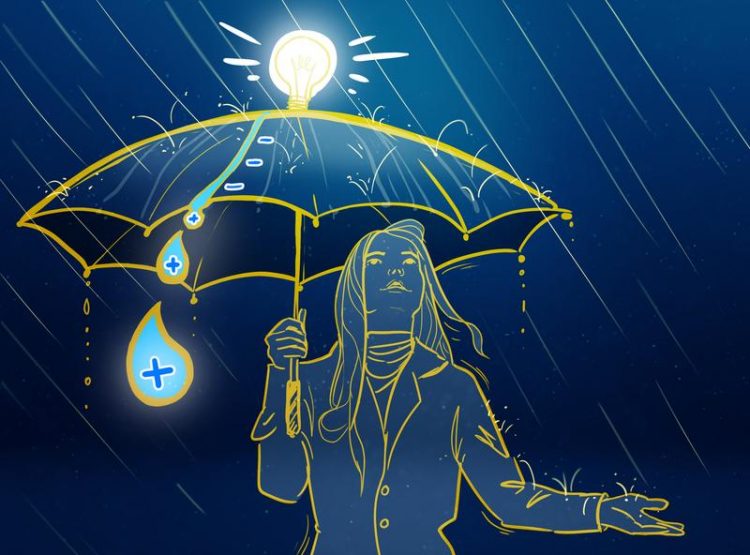Harnessing the rain for hydrovoltaics

Drops sliding over surfaces can separate charges. This effect could possibly be used to generate small amounts of power where no other source is available. Image reproduced by permission of Amy Stetten from “RSC Soft Matter”
Water drops sliding over non-conducting surfaces can be found everywhere in our lives: From the dripping of a coffee machine, to a rinse in the shower, to an umbrella in a thunderstorm.
When a drop slides over such a surface, it generates a trace of charge. Consequently, the drop collects the inverse charge. Although this charging phenomenon seems omnipresent, little is known about it.
Scientists at the MPI-P have now investigated this effect in more detail. For this, they slid drops one after another down a tilted surface of hydrophobic glass.
They measured the charge collected dependent on the sliding length as well as on the charge left by previous slipping drops.
They created a theoretical model that combines two opposing effects: the fast deposition of charge by successive drops, and the slow discharging of the surface behind the drops.
“The model matches our experimental observations beautifully”, says Dr. Amy Stetten, working as a Postdoc in the group of Profs. Stefan Weber and Hans-Jürgen Butt.
By taking their newly developed model, the researchers hope to understand basic physical effects like frictional electricity, and also to develop surfaces that enhance this effect for power generation.
The related effect of frictional electricity is also poorly understood. However, it could be that water charging and frictional charging are related. Many of us experience this when blow-drying our hair.
“When two hairs come into contact and charge up, it’s never just the two hairs, it’s the two hairs with a layer of water in between. Some experiments in the literature show that if you go down to near zero humidity, you no longer see frictional charging,” says Stetten.
From an application point of view, the effect could be used to generate small amounts of power where no other source is available. This could be the case, for example, for small, low-power sensors in isolated, rainy environments.
The researchers will continue the work to better understand how the material of the surface, or properties like surface roughness, affect the separation of charges. They aim to create materials, which separate charges more effectively so that these surfaces can be used for real-world applications.
The results of their research have been published in the renowned journal “Soft Matter”.
Dr. Amy Zufall Stetten: stetten@mpip-mainz.mpg.de
Prof. Dr. Stefan Weber: webers@mpip-mainz.mpg.de
Prof. Dr. Hans-Jürgen Butt: butt@mpip-mainz.mpg.de
Stetten, A. Z.; Golovko, D. S.; Weber, S. A. L.; Butt, H.-J.: Slide electrification: charging of surfaces by moving water drops. Soft Matter 15 (43), S. 8667 – 8679 (2019)
https://dx.doi.org/10.1039/c9sm01348b
Media Contact
More Information:
http://www.mpip-mainz.mpg.deAll latest news from the category: Power and Electrical Engineering
This topic covers issues related to energy generation, conversion, transportation and consumption and how the industry is addressing the challenge of energy efficiency in general.
innovations-report provides in-depth and informative reports and articles on subjects ranging from wind energy, fuel cell technology, solar energy, geothermal energy, petroleum, gas, nuclear engineering, alternative energy and energy efficiency to fusion, hydrogen and superconductor technologies.
Newest articles

High-energy-density aqueous battery based on halogen multi-electron transfer
Traditional non-aqueous lithium-ion batteries have a high energy density, but their safety is compromised due to the flammable organic electrolytes they utilize. Aqueous batteries use water as the solvent for…

First-ever combined heart pump and pig kidney transplant
…gives new hope to patient with terminal illness. Surgeons at NYU Langone Health performed the first-ever combined mechanical heart pump and gene-edited pig kidney transplant surgery in a 54-year-old woman…

Biophysics: Testing how well biomarkers work
LMU researchers have developed a method to determine how reliably target proteins can be labeled using super-resolution fluorescence microscopy. Modern microscopy techniques make it possible to examine the inner workings…





















